
Am Fam Physician. 2012;85(5):483-493
Patient information: See related handout on bipolar disorders, written by the authors of this article.
Author disclosure: No relevant financial affiliations to disclose.
Bipolar disorders are common, disabling, recurrent mental health conditions of variable severity. Onset is often in late childhood or early adolescence. Patients with bipolar disorders have higher rates of other mental health disorders and general medical conditions. Early recognition and treatment of bipolar disorders improve outcomes. Treatment of mood episodes depends on the presenting phase of illness: mania, hypomania, mixed state, depression, or maintenance. Psychotherapy and mood stabilizers, such as lithium, anticonvulsants, and antipsychotics, are first-line treatments that should be continued indefinitely because of the risk of relapse. Monotherapy with antidepressants is contraindicated in mixed states, manic episodes, and bipolar I disorder. Maintenance therapy for patients involves screening for suicidal ideation and substance abuse, evaluating adherence to treatment, and recognizing metabolic complications of pharmacotherapy. Active management of body weight reduces complications and improves lipid control. Patients and their support systems should be educated about mood relapse, suicidal ideation, and the effectiveness of early intervention to reduce complications.
Bipolar disorders often are first diagnosed in adolescence or early adulthood after several years of symptoms. Symptoms include periods of mania, hypomania, psychosis, or depression interspersed with periods of relative wellness. The clinical course of bipolar disorders varies. Patients rarely experience a single episode, with relapse rates reported at more than 70 percent over five years.1 Although bipolar disorders are defined by the presence of manic or hypomanic symptoms, most patients are depressed most of the time, which is also a major source of disability.2
| Clinical recommendation | Evidence rating | References | Comments |
|---|---|---|---|
| Patients 12 to 18 years of age should be screened for depressive disorders in practice settings with systems in place to support accurate diagnosis, psychotherapy, and follow-up. | B | 20 | Systematic review of randomized and controlled clinical trials regarding treatment generalized to screening |
| Lithium, valproate, and some antipsychotics are effective treatments for acute mania in bipolar disorders. | A | 7, 27 | Meta-analyses of randomized studies |
| Lithium, valproate, lamotrigine (Lamictal), and some antipsychotics are effective treatments for acute depression in bipolar disorders. | A | 27, 40 | Meta-analysis and systematic review of randomized studies |
| Lithium, valproate, lamotrigine, and some atypical antipsychotics are effective for maintenance therapy of bipolar disorders. | A | 27, 43, 44 | Meta-analysis and systematic reviews of randomized studies |
| Social support in recognizing early warning signs of mood relapse improves outcomes in patients with bipolar disorders. | A | 33 | Systematic review of randomized studies |
Bipolar disorders include four subtypes: bipolar I, bipolar II, cyclothymia, and bipolar disorder not otherwise specified (Table 1).3 Criteria for mood episodes involved in diagnosing bipolar disorders are defined in Table 2.3 Each subtype can be divided using specifiers, such as description of the patient's current or most recent episode. The rapid-cycling specifier can be applied to bipolar I or II disorder if the patient has had at least four mood episodes in the previous 12 months, and the episodes were demarcated by partial or full remission for at least two months or a switch to an episode of opposite polarity (e.g., major depressive episode to manic episode).3
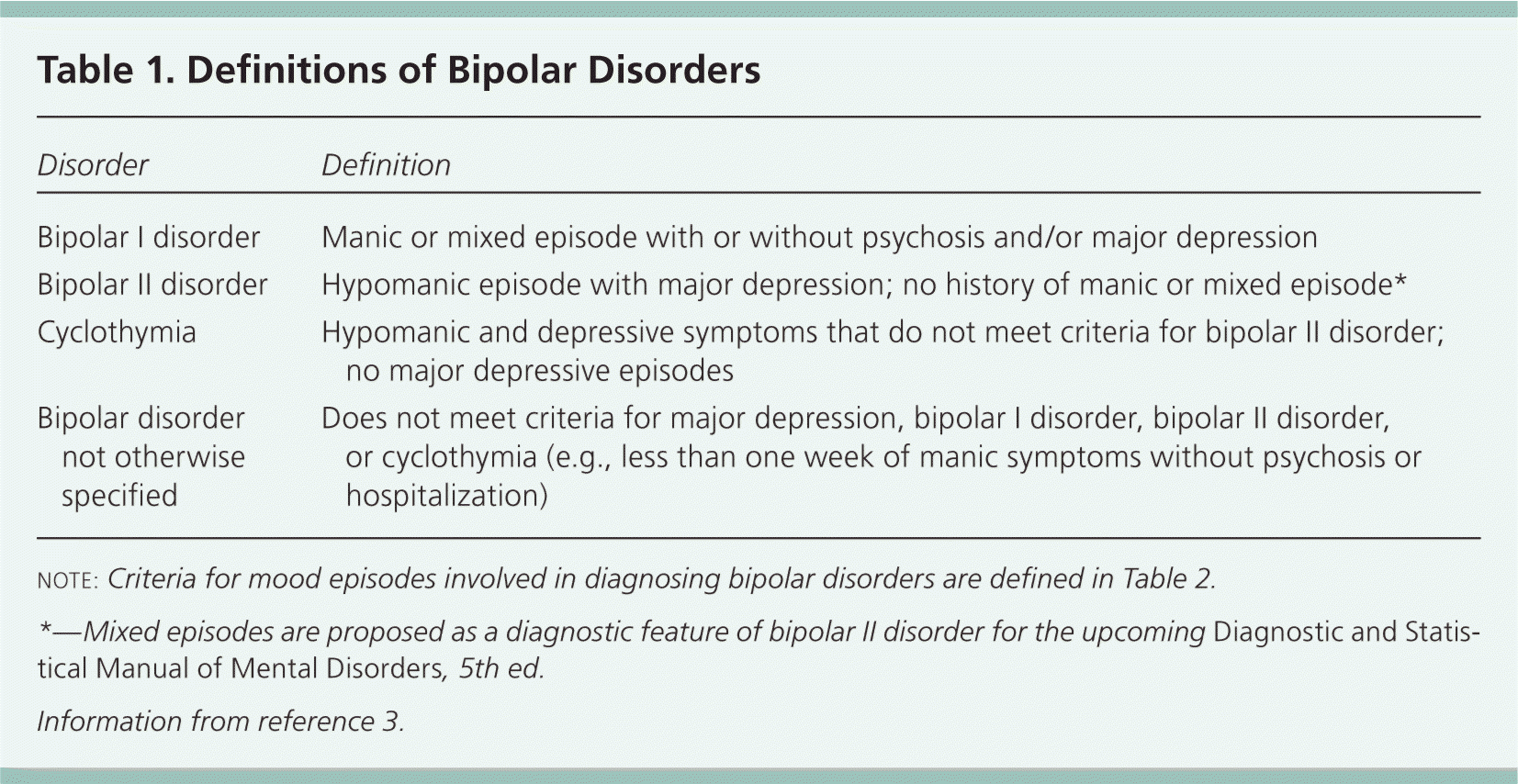
| Disorder | Definition |
|---|---|
| Bipolar I disorder | Manic or mixed episode with or without psychosis and/or major depression |
| Bipolar II disorder | Hypomanic episode with major depression; no history of manic or mixed episode* |
| Cyclothymia | Hypomanic and depressive symptoms that do not meet criteria for bipolar II disorder; no major depressive episodes |
| Bipolar disorder not otherwise specified | Does not meet criteria for major depression, bipolar I disorder, bipolar II disorder, or cyclothymia (e.g., less than one week of manic symptoms without psychosis or hospitalization) |
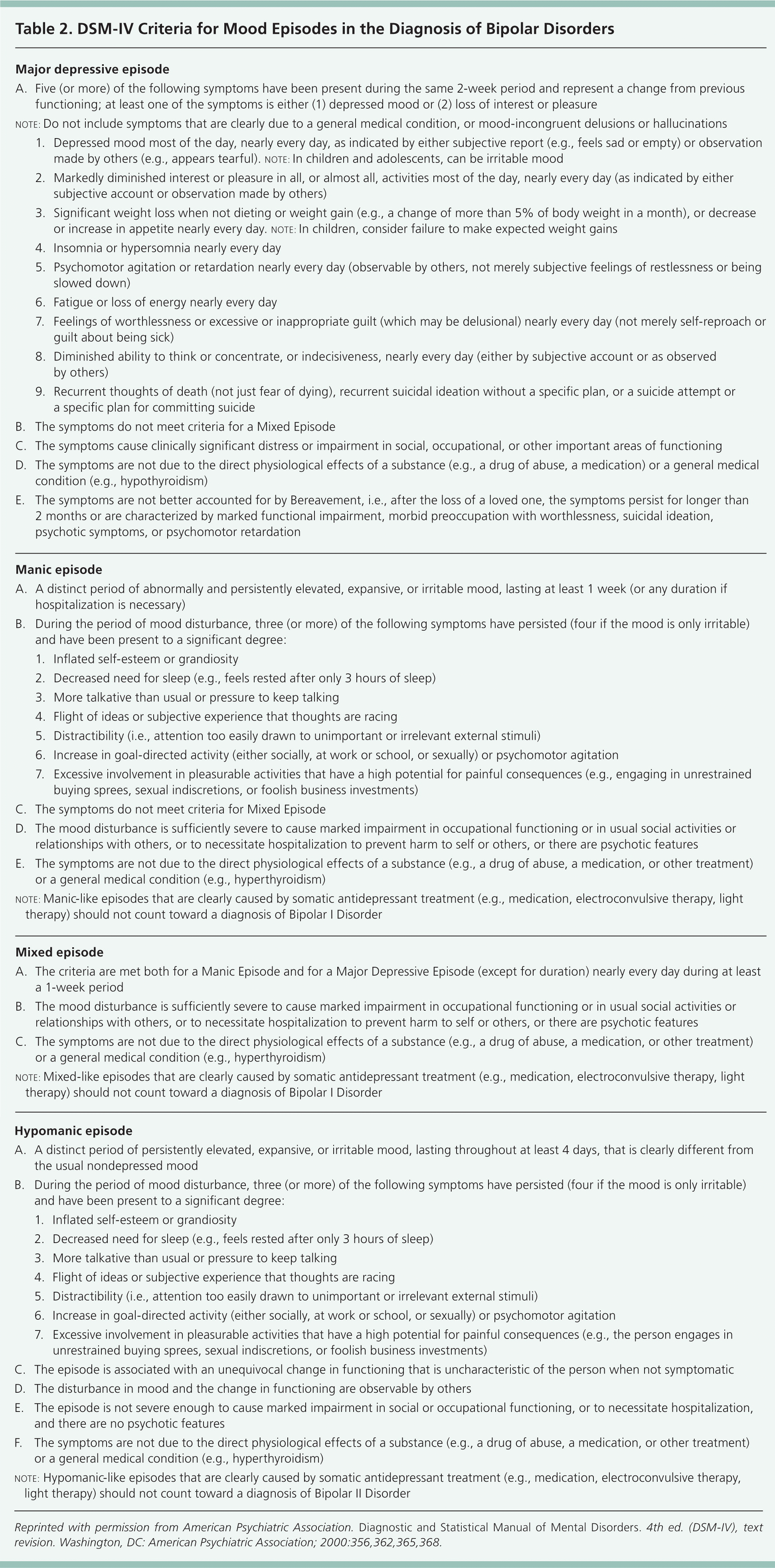
| Major depressive episode | |
| A. Five (or more) of the following symptoms have been present during the same 2-week period and represent a change from previous functioning; at least one of the symptoms is either (1) depressed mood or (2) loss of interest or pleasure | |
| note: Do not include symptoms that are clearly due to a general medical condition, or mood-incongruent delusions or hallucinations | |
| 1. Depressed mood most of the day, nearly every day, as indicated by either subjective report (e.g., feels sad or empty) or observation made by others (e.g., appears tearful). NOTE: In children and adolescents, can be irritable mood | |
| 2. Markedly diminished interest or pleasure in all, or almost all, activities most of the day, nearly every day (as indicated by either subjective account or observation made by others) | |
| 3. Significant weight loss when not dieting or weight gain (e.g., a change of more than 5% of body weight in a month), or decrease or increase in appetite nearly every day. NOTE: In children, consider failure to make expected weight gains | |
| 4. Insomnia or hypersomnia nearly every day | |
| 5. Psychomotor agitation or retardation nearly every day (observable by others, not merely subjective feelings of restlessness or being slowed down) | |
| 6. Fatigue or loss of energy nearly every day | |
| 7. Feelings of worthlessness or excessive or inappropriate guilt (which may be delusional) nearly every day (not merely self-reproach or guilt about being sick) | |
| 8. Diminished ability to think or concentrate, or indecisiveness, nearly every day (either by subjective account or as observed by others) | |
| 9. Recurrent thoughts of death (not just fear of dying), recurrent suicidal ideation without a specific plan, or a suicide attempt or a specific plan for committing suicide | |
| B. The symptoms do not meet criteria for a Mixed Episode | |
| C. The symptoms cause clinically significant distress or impairment in social, occupational, or other important areas of functioning | |
| D. The symptoms are not due to the direct physiological effects of a substance (e.g., a drug of abuse, a medication) or a general medical condition (e.g., hypothyroidism) | |
| E. The symptoms are not better accounted for by Bereavement, i.e., after the loss of a loved one, the symptoms persist for longer than 2 months or are characterized by marked functional impairment, morbid preoccupation with worthlessness, suicidal ideation, psychotic symptoms, or psychomotor retardation | |
| Manic episode | |
| A. A distinct period of abnormally and persistently elevated, expansive, or irritable mood, lasting at least 1 week (or any duration if hospitalization is necessary) | |
| B. During the period of mood disturbance, three (or more) of the following symptoms have persisted (four if the mood is only irritable) and have been present to a significant degree: | |
| 1. Inflated self-esteem or grandiosity | |
| 2. Decreased need for sleep (e.g., feels rested after only 3 hours of sleep) | |
| 3. More talkative than usual or pressure to keep talking | |
| 4. Flight of ideas or subjective experience that thoughts are racing | |
| 5. Distractibility (i.e., attention too easily drawn to unimportant or irrelevant external stimuli) | |
| 6. Increase in goal-directed activity (either socially, at work or school, or sexually) or psychomotor agitation | |
| 7. Excessive involvement in pleasurable activities that have a high potential for painful consequences (e.g., engaging in unrestrained buying sprees, sexual indiscretions, or foolish business investments) | |
| C. The symptoms do not meet criteria for Mixed Episode | |
| D. The mood disturbance is sufficiently severe to cause marked impairment in occupational functioning or in usual social activities or relationships with others, or to necessitate hospitalization to prevent harm to self or others, or there are psychotic features | |
| E. The symptoms are not due to the direct physiological effects of a substance (e.g., a drug of abuse, a medication, or other treatment) or a general medical condition (e.g., hyperthyroidism) | |
| note: Manic-like episodes that are clearly caused by somatic antidepressant treatment (e.g., medication, electroconvulsive therapy, light therapy) should not count toward a diagnosis of Bipolar I Disorder | |
| Mixed episode | |
| A. The criteria are met both for a Manic Episode and for a Major Depressive Episode (except for duration) nearly every day during at least a 1-week period | |
| B. The mood disturbance is sufficiently severe to cause marked impairment in occupational functioning or in usual social activities or relationships with others, or to necessitate hospitalization to prevent harm to self or others, or there are psychotic features | |
| C. The symptoms are not due to the direct physiological effects of a substance (e.g., a drug of abuse, a medication, or other treatment) or a general medical condition (e.g., hyperthyroidism) | |
| note: Mixed-like episodes that are clearly caused by somatic antidepressant treatment (e.g., medication, electroconvulsive therapy, light therapy) should not count toward a diagnosis of Bipolar I Disorder | |
| Hypomanic episode | |
| A. A distinct period of persistently elevated, expansive, or irritable mood, lasting throughout at least 4 days, that is clearly different from the usual nondepressed mood | |
| B. During the period of mood disturbance, three (or more) of the following symptoms have persisted (four if the mood is only irritable) and have been present to a significant degree: | |
| 1. Inflated self-esteem or grandiosity | |
| 2. Decreased need for sleep (e.g., feels rested after only 3 hours of sleep) | |
| 3. More talkative than usual or pressure to keep talking | |
| 4. Flight of ideas or subjective experience that thoughts are racing | |
| 5. Distractibility (i.e., attention too easily drawn to unimportant or irrelevant external stimuli) | |
| 6. Increase in goal-directed activity (either socially, at work or school, or sexually) or psychomotor agitation | |
| 7. Excessive involvement in pleasurable activities that have a high potential for painful consequences (e.g., the person engages in unrestrained buying sprees, sexual indiscretions, or foolish business investments) | |
| C. The episode is associated with an unequivocal change in functioning that is uncharacteristic of the person when not symptomatic | |
| D. The disturbance in mood and the change in functioning are observable by others | |
| E. The episode is not severe enough to cause marked impairment in social or occupational functioning, or to necessitate hospitalization, and there are no psychotic features | |
| F. The symptoms are not due to the direct physiological effects of a substance (e.g., a drug of abuse, a medication, or other treatment) or a general medical condition (e.g., hyperthyroidism) | |
| note: Hypomanic-like episodes that are clearly caused by somatic antidepressant treatment (e.g., medication, electroconvulsive therapy, light therapy) should not count toward a diagnosis of Bipolar II Disorder | |
Epidemiology
In 2004, the World Health Organization ranked bipolar disorders collectively as the 12th most common moderately to severely disabling condition in the world for any age group,4 with a lifetime prevalence of 4 percent in the United States.5 Bipolar disorders have no predilection for race, sex, or ethnicity. Although they can occur at any age, bipolar disorders are most common in persons younger than 25 years. The mean age at symptom onset is 18 years in bipolar I disorder and 22 years in bipolar II disorder.5
Bipolar disorders are common in primary care settings. Among patients presenting with depression or anxiety, 21 to 26 percent will meet criteria for bipolar disorders using a structured interview.6 Patients with bipolar disorders often have other mental health conditions,5 most commonly anxiety disorders, impulse control and attention-deficit/hyperactivity disorders, and substance abuse, which are associated with worse outcomes.7 General medical conditions, including diabetes mellitus, obesity, and cardiovascular disease, are more common in patients with bipolar disorders compared with age-matched cohorts, and cardiovascular risk is higher in those with bipolar disorders than in those with other mental health conditions.8 Although use of medications to treat bipolar disorders may increase susceptibility to metabolic syndrome, patients with untreated bipolar disorders have significantly higher rates of death from cardiovascular causes.8 Suicide rates are 20 times higher in patients with bipolar disorders than in the general population.9 One-third of patients with bipolar disorders attempt suicide, a rate that is among the highest of any psychiatric diagnosis.10
Etiology
Children of parents with bipolar disorders have a 4 to 15 percent risk of also being affected, compared with a 0 to 2 percent risk in children of parents without bipolar disorders.11 Environmental factors are strongly associated with the inheritance pattern.12 These factors include stressful life events, particularly suicide of a family member; disruptions in the sleep cycle; and family members or caregivers with high expressed emotion, a communication pattern defined as emotionally overinvolved, hostile, and critical.13 Research indicates that bipolar disorders, schizophrenia, and major depressive disorders share biologic susceptibility and inheritance patterns.14,15 New data have identified several genes and loci that may be associated with bipolar disorders, including glycogen synthase kinase-3β.16
Clinical Presentation
Patients with bipolar disorders often present for treatment with depression or in a mixed state17 (i.e., depressed mood combined with increased energy, restlessness, and racing thoughts). The diagnosis may be delayed because a series of depressive episodes may occur before a mixed, manic, or hypomanic episode manifests. Physicians need to ask all patients with depression if they have had symptoms of mania or hypomania (e.g., changes in energy, racing thoughts, decreased need for sleep, or a mood that was distinctly better than usual for a brief period in the past). Historical clues that raise suspicion for bipolar disorders are listed in Table 3.18 Mixed states are of significant concern because heightened energy increases the risk of suicide.19
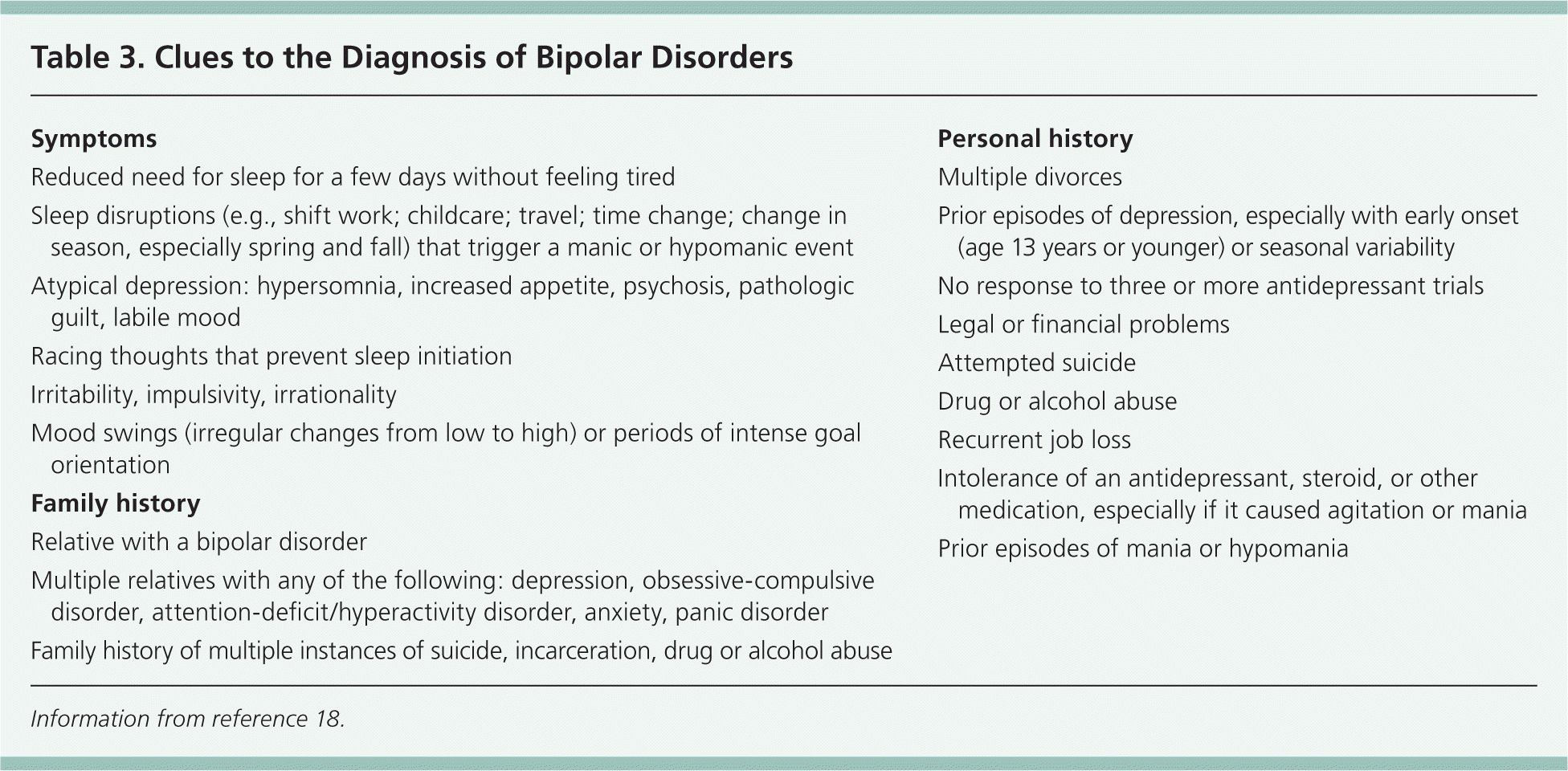
| Symptoms |
| Reduced need for sleep for a few days without feeling tired |
| Sleep disruptions (e.g., shift work; childcare; travel; time change; change in season, especially spring and fall) that trigger a manic or hypomanic event |
| Atypical depression: hypersomnia, increased appetite, psychosis, pathologic guilt, labile mood |
| Racing thoughts that prevent sleep initiation |
| Irritability, impulsivity, irrationality |
| Mood swings (irregular changes from low to high) or periods of intense goal orientation |
| Family history |
| Relative with a bipolar disorder |
| Multiple relatives with any of the following: depression, obsessive-compulsive disorder, attention-deficit/hyperactivity disorder, anxiety, panic disorder |
| Family history of multiple instances of suicide, incarceration, drug or alcohol abuse |
| Personal history |
| Multiple divorces |
| Prior episodes of depression, especially with early onset (age 13 years or younger) or seasonal variability |
| No response to three or more antidepressant trials |
| Legal or financial problems |
| Attempted suicide |
| Drug or alcohol abuse |
| Recurrent job loss |
| Intolerance of an antidepressant, steroid, or other medication, especially if it caused agitation or mania |
| Prior episodes of mania or hypomania |
Evaluation
Screening for depressive disorders is recommended for patients 12 to 18 years of age in practice settings with systems in place to support accurate diagnosis, psychotherapy, and follow-up using the age-appropriate Patient Health Questionnaire (available at http://www.depression-primarycare.org/clinicians/) or the Beck Depression Inventory–Primary Care Version.20 With a high negative predictive value, office-based tools, including the Bipolar Spectrum Diagnostic Scale, the My Mood Monitor (M-3) checklist, and the Mood Disorder Questionnaire (available at http://www.dbsalliance.org/pdfs/MDQ.pdf), can be useful in ruling out bipolar disorders, but they are not sufficient to confirm a diagnosis.21-23
The medical evaluation of patients with a suspected bipolar disorder is based on ruling out other causes of the patient's symptoms (Table 424 ) and can assist in selecting a medication. Secondary mania should be more strongly considered in patients presenting with a first episode in prepuberty or after 40 years of age.25 Appropriate evaluation for diabetes and lipid abnormalities, which are associated with the disorders and their treatment, is also needed. Table 5 includes tests that can be considered in the evaluation of patients with a suspected bipolar disorder.25
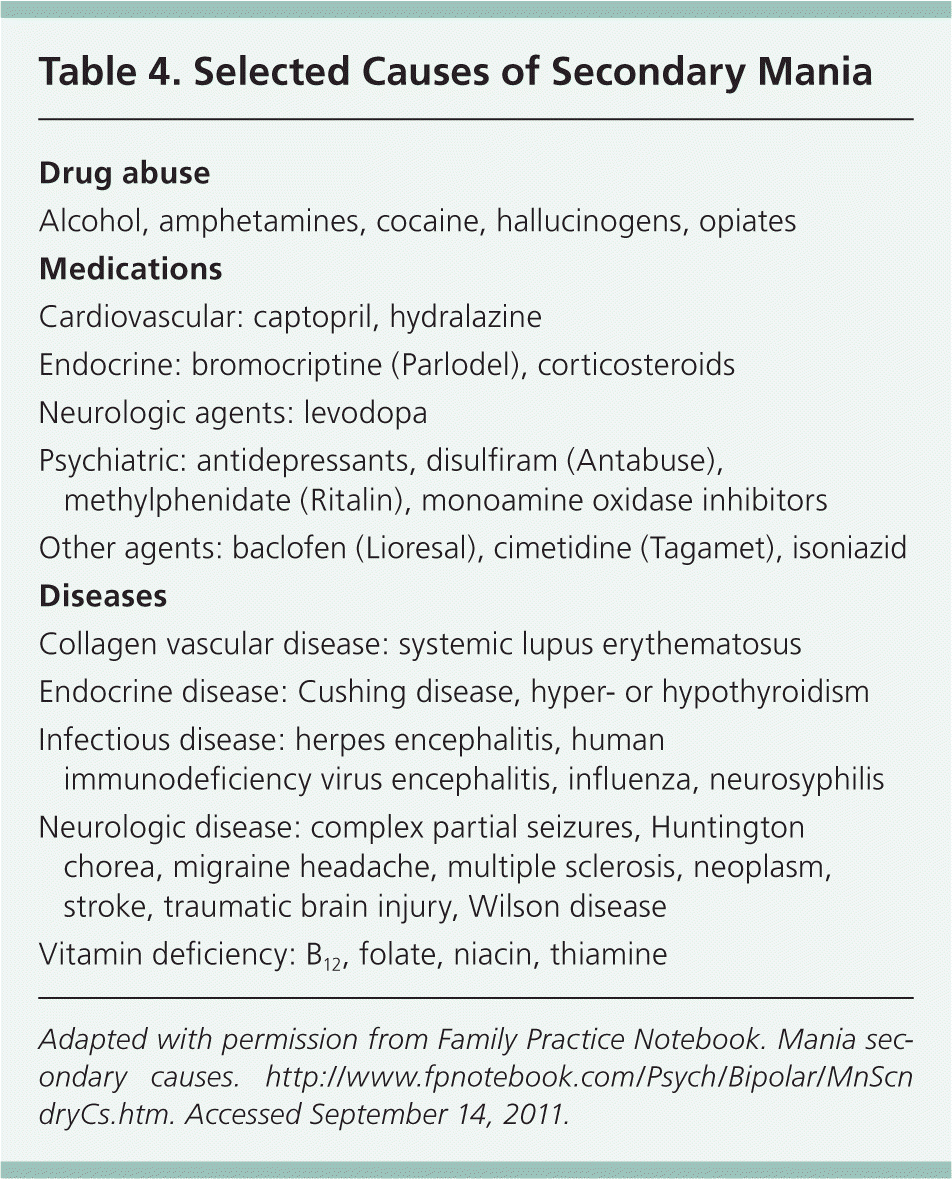
| Drug abuse |
| Alcohol, amphetamines, cocaine, hallucinogens, opiates |
| Medications |
| Cardiovascular: captopril, hydralazine |
| Endocrine: bromocriptine (Parlodel), corticosteroids |
| Neurologic agents: levodopa |
| Psychiatric: antidepressants, disulfiram (Antabuse), methylphenidate (Ritalin), monoamine oxidase inhibitors |
| Other agents: baclofen (Lioresal), cimetidine (Tagamet), isoniazid |
| Diseases |
| Collagen vascular disease: systemic lupus erythematosus |
| Endocrine disease: Cushing disease, hyper- or hypothyroidism |
| Infectious disease: herpes encephalitis, human immunodeficiency virus encephalitis, influenza, neurosyphilis |
| Neurologic disease: complex partial seizures, Huntington chorea, migraine headache, multiple sclerosis, neoplasm, stroke, traumatic brain injury, Wilson disease |
| Vitamin deficiency: B12, folate, niacin, thiamine |
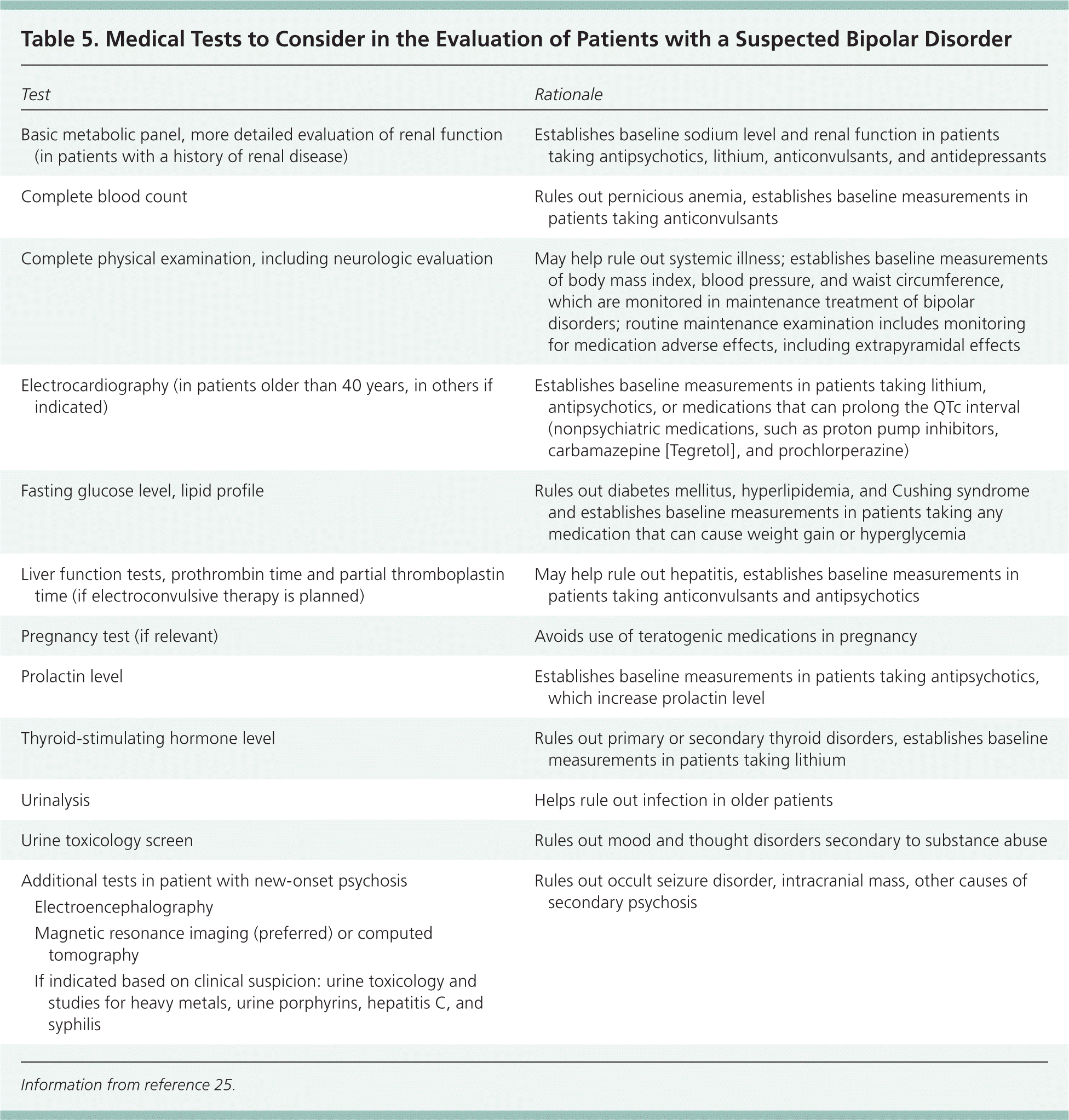
| Test | Rationale | |
|---|---|---|
| Basic metabolic panel, more detailed evaluation of renal function (in patients with a history of renal disease) | Establishes baseline sodium level and renal function in patients taking antipsychotics, lithium, anticonvulsants, and antidepressants | |
| Complete blood count | Rules out pernicious anemia, establishes baseline measurements in patients taking anticonvulsants | |
| Complete physical examination, including neurologic evaluation | May help rule out systemic illness; establishes baseline measurements of body mass index, blood pressure, and waist circumference, which are monitored in maintenance treatment of bipolar disorders; routine maintenance examination includes monitoring for medication adverse effects, including extrapyramidal effects | |
| Electrocardiography (in patients older than 40 years, in others if indicated) | Establishes baseline measurements in patients taking lithium, antipsychotics, or medications that can prolong the QTc interval (nonpsychiatric medications, such as proton pump inhibitors, carbamazepine [Tegretol], and prochlorperazine) | |
| Fasting glucose level, lipid profile | Rules out diabetes mellitus, hyperlipidemia, and Cushing syndrome and establishes baseline measurements in patients taking any medication that can cause weight gain or hyperglycemia | |
| Liver function tests, prothrombin time and partial thromboplastin time (if electroconvulsive therapy is planned) | May help rule out hepatitis, establishes baseline measurements in patients taking anticonvulsants and antipsychotics | |
| Pregnancy test (if relevant) | Avoids use of teratogenic medications in pregnancy | |
| Prolactin level | Establishes baseline measurements in patients taking antipsychotics, which increase prolactin level | |
| Thyroid-stimulating hormone level | Rules out primary or secondary thyroid disorders, establishes baseline measurements in patients taking lithium | |
| Urinalysis | Helps rule out infection in older patients | |
| Urine toxicology screen | Rules out mood and thought disorders secondary to substance abuse | |
| Additional tests in patient with new-onset psychosis | Rules out occult seizure disorder, intracranial mass, other causes of secondary psychosis | |
| Electroencephalography | ||
| Magnetic resonance imaging (preferred) or computed tomography | ||
| If indicated based on clinical suspicion: urine toxicology and studies for heavy metals, urine porphyrins, hepatitis C, and syphilis | ||
Treatment
Early diagnosis and treatment of acute mood episodes improve prognosis by reducing the risk of relapse and doubling the rate of response to medications.26 Medication selection (Table 66,7,27–30 ) depends on the presenting phase of illness and its severity. Treatment should continue indefinitely because of the risk of relapse, which occurs in one-third of patients in the first year after presentation and in more than 70 percent of patients within five years.1 Comanagement with a psychiatrist is often required because of relapse, treatment resistance, comorbid psychiatric conditions, and the risk of patients harming themselves or others. Women of childbearing age should be educated about the teratogenic effects of most mood stabilizers and the importance of using reliable contraception while taking these medications. Monotherapy with antidepressants is contraindicated in patients with mixed states, manic episodes, or bipolar I disorder.
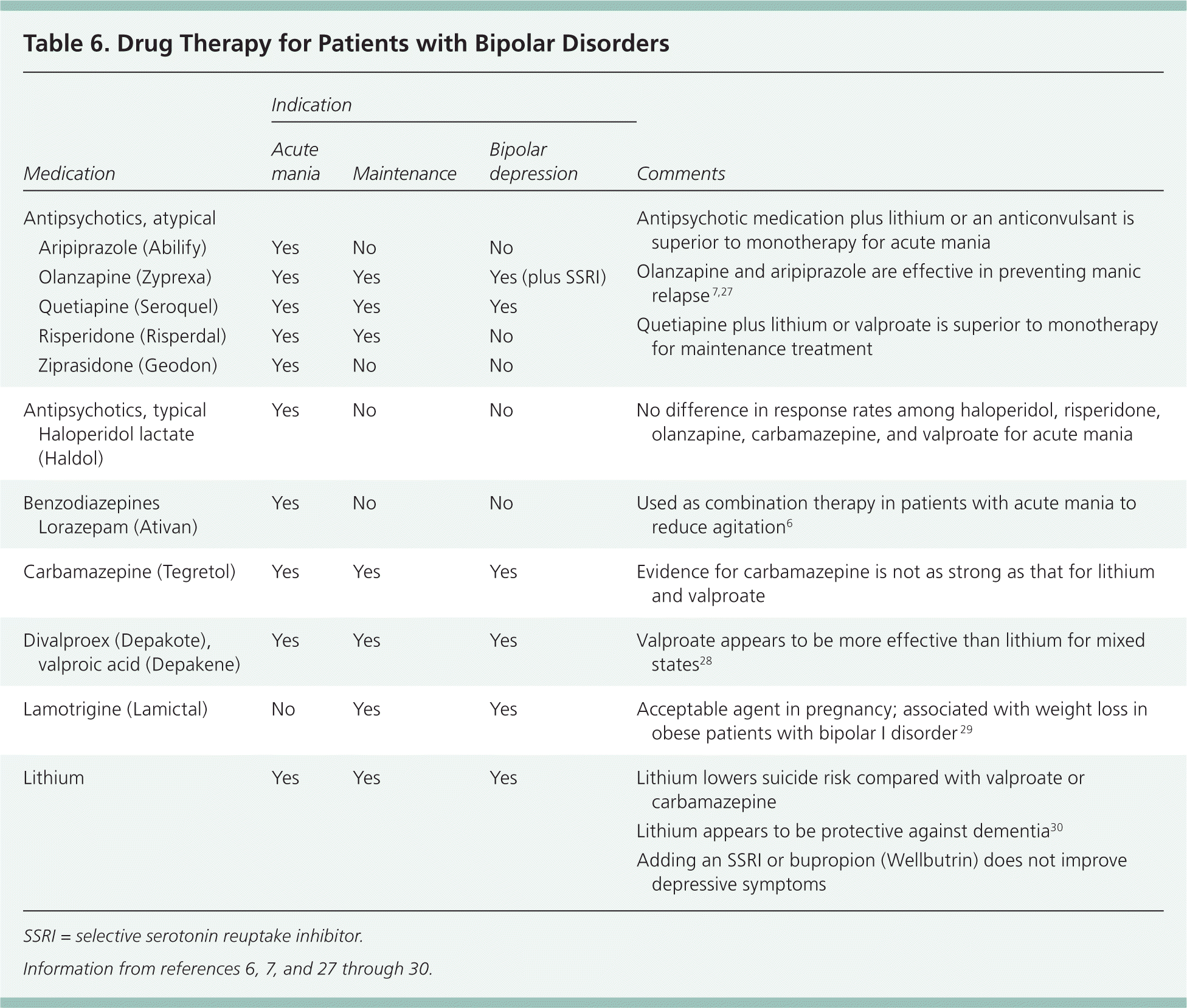
| Medication | Indication | Comments | |||
|---|---|---|---|---|---|
| Acute mania | Maintenance | Bipolar depression | |||
| Antipsychotics, atypical | |||||
| Aripiprazole (Abilify) | Yes | No | No | ||
| Olanzapine (Zyprexa) | Yes | Yes | Yes (plus SSRI) | ||
| Quetiapine (Seroquel) | Yes | Yes | Yes | ||
| Risperidone (Risperdal) | Yes | Yes | No | ||
| Ziprasidone (Geodon) | Yes | No | No | ||
| Antipsychotics, typical | Yes | No | No |
| |
| Haloperidol lactate (Haldol) | |||||
| Benzodiazepines | Yes | No | No |
| |
| Lorazepam (Ativan) | |||||
| Carbamazepine (Tegretol) | Yes | Yes | Yes |
| |
| Divalproex (Depakote), valproic acid (Depakene) | Yes | Yes | Yes |
| |
| Lamotrigine (Lamictal) | No | Yes | Yes |
| |
| Lithium | Yes | Yes | Yes |
| |
Electroconvulsive therapy can be effective for mania and psychotic depression.27 Behavioral interventions (e.g., cognitive behavior therapy, caregiver support, psychoeducation regarding the early warning signs of mood relapse) are considered first-line adjuncts to pharmacotherapy to improve social function and reduce the need for medications, number of hospitalizations, and relapse rates.7,31–33 Early warning signs of a mood relapse include sleep disturbance, agitation, increased goal orientation, and a disruption in usual routine. The risk of suicide is lowered with increased satisfaction with care, lithium therapy, and treatment of alcohol and tobacco abuse.7,9,34
ACUTE MANIA
Patients with acute mania need to be hospitalized because they could harm themselves or others. The goal of initial treatment includes adequate sleep and reduction of psychotic symptoms. High-quality evidence supports the use of the mood stabilizers lithium and valproate and of antipsychotics.7,28,35–37 Lithium is the treatment of choice for classic euphoric mania.38 It is often given in conjunction with an antipsychotic and a benzodiazepine in the acute phase,6 because lithium takes a number of days to reach steady state. Combination therapy with lithium or valproate plus an antipsychotic is superior to either agent alone in the resolution of acute mania.38
Patients with acute hypomania should be assessed for decision-making capacity and the ability to comply with treatment. An ensuing major depressive episode is a major source of morbidity in patients with hypomania.
MIXED STATES
Lithium does not benefit patients in mixed states or those who have rapid cycling. Valproate is often used because it can be titrated quickly and has been shown to be effective in mixed states.27 Although other anticonvulsants are used, there is no evidence to support them.
ACUTE DEPRESSION
Patients with acute depression should be assessed for suicidal or homicidal ideation and the need for inpatient treatment. Recommendations for drug therapy are partly based on the time it takes to titrate the medications. Several agents are effective for acute depression, including lithium.27 Lamotrigine (Lamictal) is effective, but a minimum of six weeks of titration is needed to mitigate the risk of Stevens-Johnson syndrome. Patients are highly responsive to quetiapine (Seroquel) after one week of use, but the medication is associated with weight gain and extrapyramidal effects.39
There is no evidence to support combination therapy or the addition of an antidepressant in the acute phase of depression.40 In a study of patients with bipolar II disorder, adding paroxetine (Paxil) or bupropion (Wellbutrin) was no more effective than using lithium or valproate alone.7 If a therapeutic dose of a mood stabilizer does not resolve symptoms and the patient is not in a mixed state, an antidepressant can be added. Patients may also benefit from switching mood stabilizers or adding an antipsychotic if antidepressants are contraindicated.27 Patients who are resistant to treatment should receive a selective serotonin reuptake inhibitor or bupropion for treatment augmentation when indicated, because either therapy is less likely to induce mania compared with tricyclic antidepressants or medications with dual properties, such as venlafaxine (Effexor).41 When treating sleep disturbance in patients with depression, physicians should avoid prescribing trazodone because it can induce mania.42
MAINTENANCE THERAPY
High-quality evidence supports the use of lithium, lamotrigine, valproate, quetiapine, and olanzapine (Zyprexa) for maintenance therapy in patients with bipolar disorders,27,43,44 although each has specific advantages and disadvantages (Table 66,7,27–30 ). Quetiapine combined with lithium or valproate is more effective than lithium or valproate alone.27
In addition to standard prescription medications, omega-3 fatty acids have a low risk of adverse effects and can help reduce depressive symptoms in patients with bipolar disorders.45 A randomized controlled study of patients taking olanzapine showed that active management of body weight and a moderate exercise program improved weight loss and lipid profiles over baseline characteristics compared with control groups.46
MONITORING
In the maintenance phase, patients with bipolar disorders should receive regular clinical examinations that focus on depressive, manic, and sleep symptoms; suicide risk; comorbid conditions and general medical health; and substance abuse. Patients taking antipsychotic medications are at high risk of metabolic complications and adverse effects. Extrapyramidal effects often manifest early and can include akathisia (i.e., subjective sense of motor restlessness); parkinsonism (i.e., cogwheel rigidity of tendons, masked facies, or muscle stiffness or rigidity); and other movement disorders, such as dystonias and dyskinesias. Tardive dyskinesia is a potentially irreversible movement disorder that can occur within months of initiating antipsychotic therapy in older persons, who are also at risk of stroke and other cardiovascular events, and in patients with neurologic vulnerability (e.g., those with human immunodeficiency virus infection or other central nervous system diseases). Patients taking antipsychotics should be evaluated using the Abnormal Involuntary Movement Scale (http://www.cqaimh.org/pdf/tool_aims.pdf) at each follow-up visit.
Dosage reduction should be considered regularly in patients taking antipsychotic medications. Lower dosages may be required in children or older patients, patients with chronic disease, and patients who are underweight. Higher dosages are required for patients with severe psychosis.47 Table 7 summarizes dosing and monitoring recommendations for pharmacotherapy, and specific considerations for individual agents.6,48–54
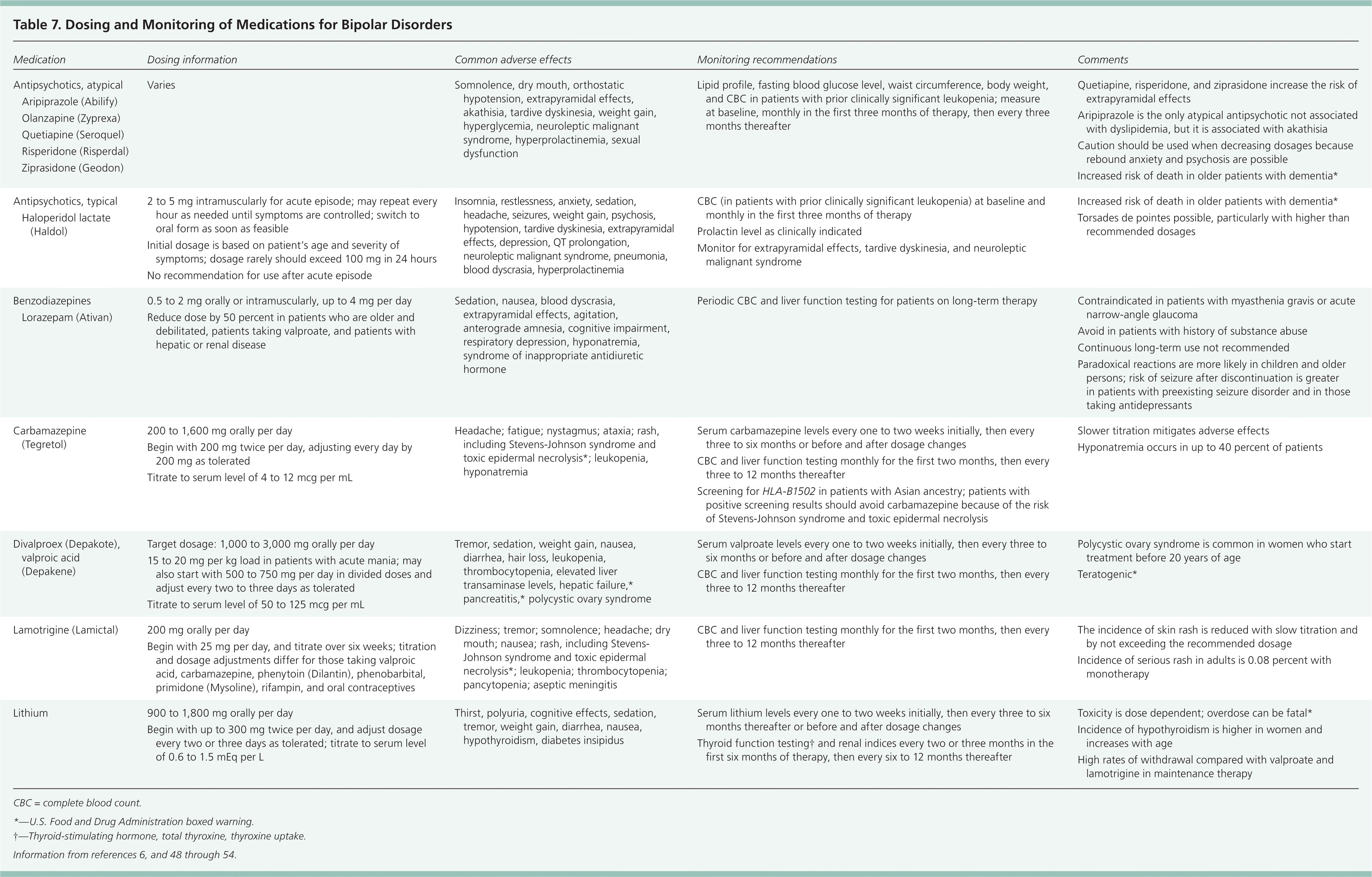
| Medication | Dosing information | Common adverse effects | Monitoring recommendations | Comments | |
|---|---|---|---|---|---|
Antipsychotics, atypical
| Varies | Somnolence, dry mouth, orthostatic hypotension, extrapyramidal effects, akathisia, tardive dyskinesia, weight gain, hyperglycemia, neuroleptic malignant syndrome, hyperprolactinemia, sexual dysfunction | Lipid profile, fasting blood glucose level, waist circumference, body weight, and CBC in patients with prior clinically significant leukopenia; measure at baseline, monthly in the first three months of therapy, then every three months thereafter |
| |
| Antipsychotics, typical Haloperidol lactate(Haldol) |
| Insomnia, restlessness, anxiety, sedation, headache, seizures, weight gain, psychosis, hypotension, tardive dyskinesia, extrapyramidal effects, depression, QT prolongation, neuroleptic malignant syndrome, pneumonia, blood dyscrasia, hyperprolactinemia |
|
| |
| Benzodiazepines Lorazepam (Ativan) |
| Sedation, nausea, blood dyscrasia, extrapyramidal effects, agitation, anterograde amnesia, cognitive impairment, respiratory depression, hyponatremia, syndrome of inappropriate antidiuretic hormone | Periodic CBC and liver function testing for patients on long-term therapy |
| |
| Carbamazepine (Tegretol) |
| Headache; fatigue; nystagmus; ataxia; rash, including Stevens-Johnson syndrome and toxic epidermal necrolysis*; leukopenia, hyponatremia |
|
| |
| Divalproex (Depakote), valproic acid (Depakene) |
| Tremor, sedation, weight gain, nausea, diarrhea, hair loss, leukopenia, thrombocytopenia, elevated liver transaminase levels, hepatic failure,* pancreatitis,* polycystic ovary syndrome |
|
| |
| Lamotrigine (Lamictal) |
| Dizziness; tremor; somnolence; headache; dry mouth; nausea; rash, including Stevens-Johnson syndrome and toxic epidermal necrolysis*; leukopenia; thrombocytopenia; pancytopenia; aseptic meningitis | CBC and liver function testing monthly for the first two months, then every three to 12 months thereafter |
| |
| Lithium |
| Thirst, polyuria, cognitive effects, sedation, tremor, weight gain, diarrhea, nausea, hypothyroidism, diabetes insipidus |
|
| |
Family and Psychosocial Issues
Psychosocial stress is known to trigger manic and depressive symptoms. Although there are limited and heterogeneous data to support family interventions for bipolar disorders,55 patients who have social support in recognizing early warning signs of recurrence appear to have less risk of recurrence and hospitalization and have better functioning.33 Patients who receive intensive psychotherapy 7 or group therapy 31 have fewer relapses and longer periods of relative wellness compared with patients who receive brief therapy. Patients with frequent episodes of mania may benefit from strategies that emphasize medication adherence, whereas those with more depressive symptoms benefit from treatments focused on coping strategies and cognitive behavior therapy.56 Patients, families, and caregivers should establish a plan for addressing suicidal and homicidal ideation quickly if they become apparent.
Data Sources: We searched the Cochrane Database of Systematic Reviews, DynaMed, Essential Evidence Plus, the U.S. Preventive Services Task Force, the Agency for Healthcare Research and Quality, and Clinical Evidence. A PubMed search was completed using the search subject bipolar disorder. Search dates: June 20, 2010, and May 23, 2011.
